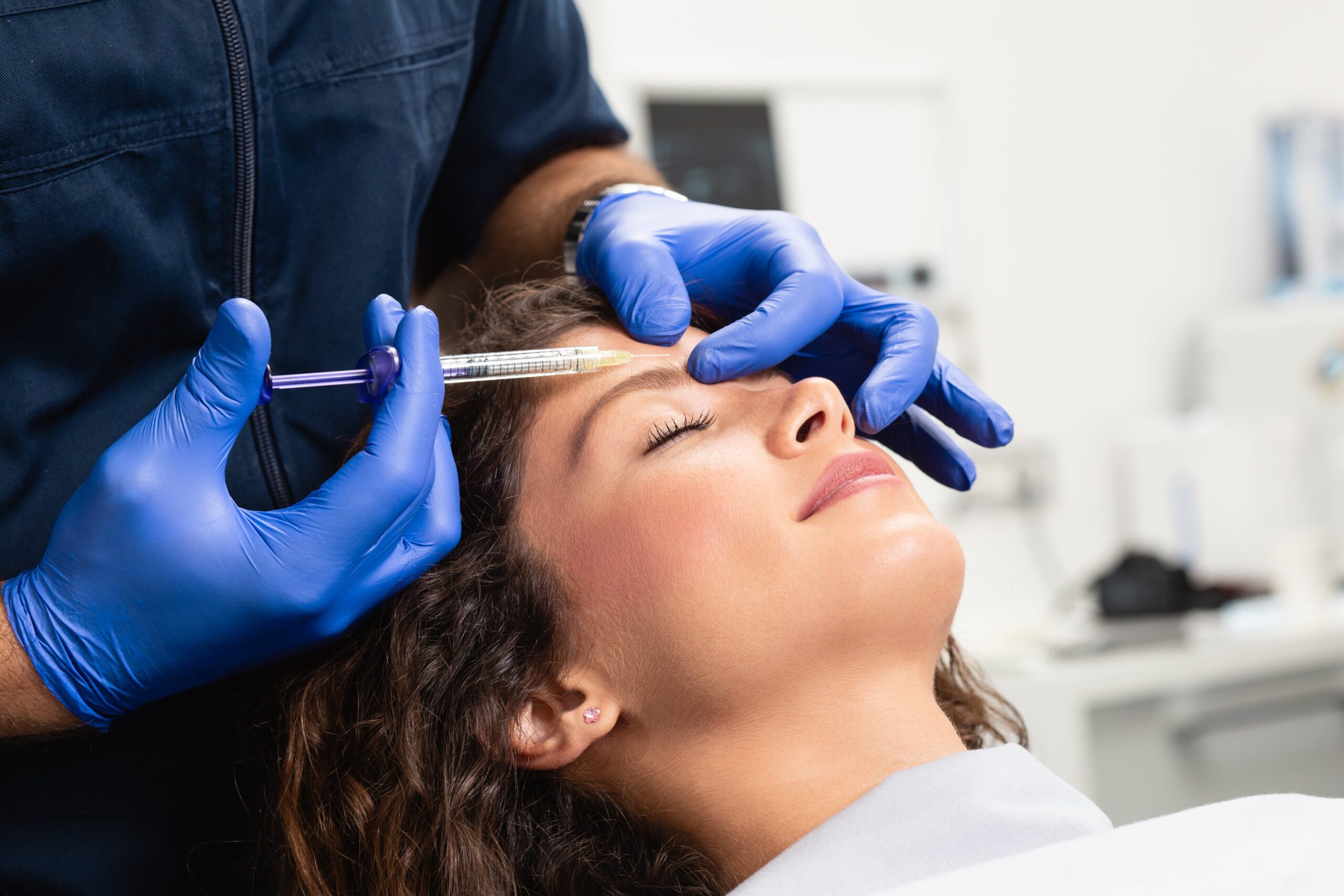Can Dysport® Cause a Permanent Drooping Eyelid?

When it comes to cosmetic treatments, Dysport® emerges as a popular choice for those seeking to diminish the appearance of fine lines and wrinkles, especially around the eyes and forehead. This injectable treatment, with its botulinum toxin ingredient, gently targets facial muscles, temporarily easing muscle activity and smoothing the skin.
While the benefits of Dysport are widely recognized, it’s natural to harbor concerns. Specifically, some worry about the possibility of permanent eyelid drooping, known as ptosis. Read on to get some insights into how Dysport works, the likelihood of experiencing ptosis, and steps you can take to mitigate this risk.
The Role of Dysport in Cosmetic Procedures
Dysport injections are a cornerstone of non-invasive facial rejuvenation, offering a less invasive alternative to surgical procedures. By effectively reducing the appearance of wrinkles and fine lines, Dysport can contribute to a more rested and youthful appearance without the downtime and risks associated with surgery.
Understanding Dysport and Its Effects
Dysport works by injecting a small amount of botulinum toxin into specific facial muscles, temporarily relaxing them, and reducing the appearance of wrinkles. This process specifically targets muscles like the frontalis muscle, which plays a significant role in forehead expression, and the eye muscle responsible for crow’s feet.
The Risk of Eyelid Drooping
While the primary aim is for the botulinum toxin to act as a muscle relaxant on targeted facial muscles, there’s a small chance that the botulinum toxin could spread to nearby muscles, affecting their function. This unintended spread can lead to droopy eyelids, a condition where the upper eyelids fall to a lower position than normal, potentially impairing vision or giving a tired appearance. Fortunately, such side effects are rare and typically temporary rather than permanent.
Remember, Dysport aims to enhance your appearance, and any potential concerns can be addressed with care.
Factors Contributing to Eyelid Ptosis
Several factors can influence the risk of developing droopy eyelids after Botox or Dysport treatment, including the following:
- Injection technique and dosage – Precise injection techniques and appropriate dosages by experienced medical professionals, such as Dr. Mark Rayman and his team at Beach Cities Vein and Laser Center, minimize the risk of botulinum toxin affecting unintended areas.
- Individual anatomy and muscle sensitivity – Each person’s facial structure and muscle sensitivity to botulinum toxin are unique, which can affect how the body responds to Dysport injections.
- Post-treatment care – Following aftercare instructions can help reduce the risk of spreading the toxin to unintended areas.
Professional Administration: Key to Minimizing Risks
The experience and expertise of the practitioner performing the Dysport injections are crucial factors in minimizing the risk of side effects, including ptosis. A thorough understanding of facial anatomy and precise injection techniques are essential to ensuring that the toxin affects only the intended muscles.
Selecting Your Provider
When choosing a provider for Dysport injections, you should select a board-certified practitioner like Dr. Rayman, who has extensive experience with botulinum toxin treatments. He relies on decades of experience as an interventional radiologist to provide minimally invasive treatments like Dysport and Botox to help patients. Professionals like him have a deep understanding of facial anatomy and are best equipped to deliver the injections safely and effectively.
Importance of Medical History
A detailed medical history is critical before undergoing Dysport treatment. Certain conditions, such as neuromuscular disorders or allergies to botulinum toxin, can increase the risk of adverse effects. Discussing your medical history with a trusted provider like Beach Cities Vein and Laser Center can help ensure a safer treatment process.
Post-Treatment Care and Management
After receiving Dysport injections, following your provider’s aftercare instructions is vital to avoid spreading the toxin to unintended areas. Recommendations typically include avoiding rubbing or massaging the treated area, staying upright for several hours, and avoiding strenuous activities for a short period of time. These precautions help ensure the botulinum toxin remains localized to the target muscles, reducing the risk of ptosis.
Addressing Concerns: Temporary Versus Permanent Effects
The prospect of eyelid drooping can be concerning, but you should understand that such side effects are usually temporary. The duration of ptosis can vary but typically lasts until the effects of botulinum toxin diminish, usually within a few months.
Permanent drooping is exceedingly rare and often attributable to other underlying conditions rather than the Dysport injection itself.
Dysport Versus Other Treatments
Dysport is often compared to other botulinum toxin products, such as Botox. While these treatments are similar in their use and effects, subtle differences in formulation can influence their distribution and effectiveness in certain areas of the face. Discussing these options with your provider, like Dr. Rayman’s reliable team can help determine the best choice for your aesthetic goals and needs.
Frequently Asked Questions About Dysport
Q: Can ptosis from Dysport be corrected before it naturally resolves?
A: While ptosis due to Dysport is generally temporary, there are treatments, such as prescription eye drops, that can help elevate the droopy eyelid slightly. These treatments may not completely reverse the effect but can offer improvement until the botulinum toxin wears off.
Q: Are there exercises I can do to reduce the impact of ptosis?
A: There aren’t specific exercises proven to reverse ptosis caused by Dysport. The condition results from the relaxation of muscle activity, so exercises won’t affect its duration. However, maintaining overall eye health through regular breaks, especially if you strain your eyes often, is beneficial.
Q: Is it safe to undergo Dysport treatments if I have had ptosis in the past?
A: Yes, it can be safe to have Dysport treatments even if you’ve experienced ptosis previously, but you should inform a provider like Dr. Rayman about your past side effects. He and his team may adjust the treatment approach, such as by modifying the injection site or dose, to minimize the risk of recurrence.
Q: Can ptosis from Dysport indicate an allergy to the treatment?
A: Ptosis following Dysport injections typically results from the spread of the toxin to unintended muscles, not an allergic reaction. Allergic reactions to Dysport are rare and would likely present with symptoms different from ptosis, such as itching, redness, or swelling at the injection site. Always inform the practitioner about any unusual reactions after treatment.
Q: Does the location of the Dysport injection affect the risk of ptosis?
A: Yes, the injection site plays a significant role in the risk of developing ptosis. Injections near the upper eyelids or eyebrows carry a higher risk. The expertise of an established provider like Beach Cities Vein and Laser Center in facial anatomy is crucial in targeting the correct muscles while avoiding those that could lead to eyelid drooping.
Set Up a Consultation
Are you considering Dysport injections? Dr. Mark Rayman, an experienced and board-certified phlebologist and interventional radiologist, and the team at Beach Cities Vein and Laser Center in El Segundo, CA, are here to provide you with a comprehensive understanding of the procedure, including its benefits and potential side effects. Contact us today to book your consultation.

